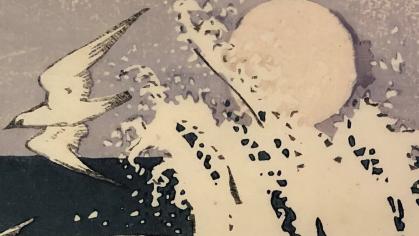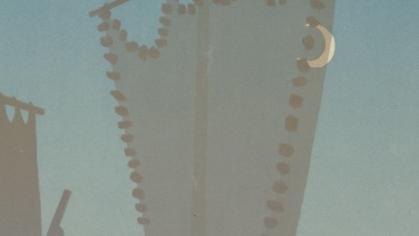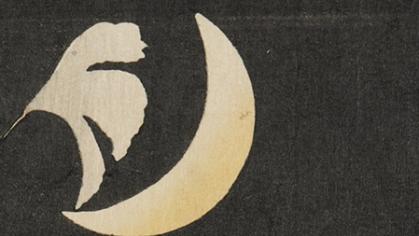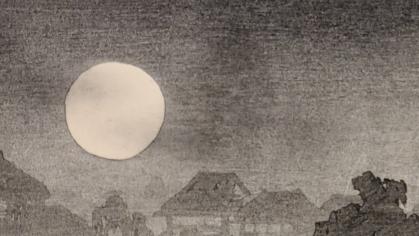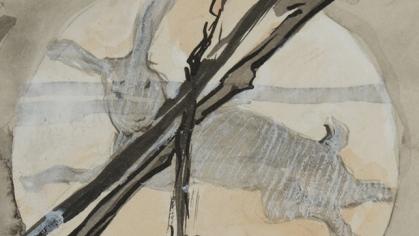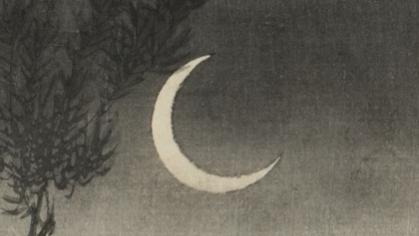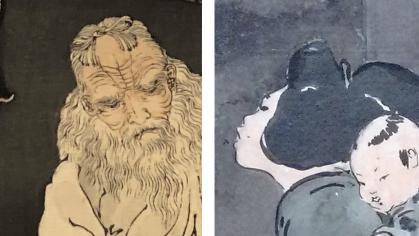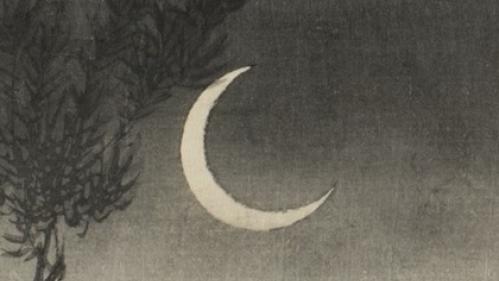
Action and Transience Underneath the Moon
The moon has been a common motif in ukiyo-e prints and images depicting themes of movement, action, and transience. This motif is prevalent throughout Japanese art and the Western movement of Japonism, such as Yoshitoshi’s Ushiwaka and Benkei and Jōganden Moon, Toshikata’s Captain Matsuzaki, and Choubrac’s Casino de Paris-Venus à Paris. These works are snapshots of specific historical events occurring within a changing landscape and provide a glimpse into the world that once was. Just like the moon’s phases, these works are a subtle reminder that nothing is constant except change itself, and the moon reflects that change. In this respect, the moon’s appearance highlights how it sets the stage for each image, reflects the passage of time in historical moments, and provides undertones of popular culture influences.
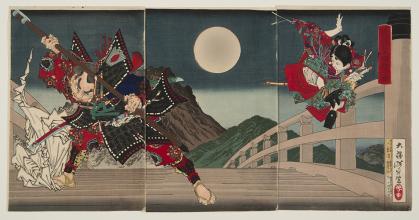
Ushiwaka and Benkei duelling on Gojo Bridge: An episode from the Chronicles of Yoshitsune
Color woodcut, 1881
Gift of Donald and Ann McPhail
Ushiwaka and Benkei duelling on Gojo Bridge is a ukiyo-e triptych by Yoshitoshi that exemplifies his love for storytelling. Although it is not part of the One Hundred Aspects of the Moon series, the moon occupies a critical place in this work. Based on a chapter in the medieval war tale, The Chronicles of Yoshitsune, this triptych portrays the initial encounter between the iconic warrior heroes Minamoto no Yoshitsune 源義経 (a.k.a. Ushiwaka) and Benkei 弁慶 on the Gojō Bridge in Kyoto in the late twelfth century. Yoshitoshi masterfully captures the moment where massive and ferocious Benkei, fully armed, is prepared to attack, while Yoshitsune, small yet agile, makes a swift dodge as he leaps into the air. The cloak he had worn over his head is now under Benkei’s foot-it must have dropped as he leapt. Benkei leans forward, as he blocks the fan that Yoshitsune threw at him with the shaft of his halberd. Anchored in the ground, he glares at Yoshitsune with fury, while Yoshitsune, floating in the air, responds with a calm glance. The flattened wooden bridge that spreads across the three sheets makes this scene seem more like a stage performance. The large full moon set high in the sky in the center serves as a spotlight that illuminates the warriors below as they confidently dance with their presumably super-human battle instincts and reflexes. The cloudless clear moon seems to celebrate the meeting of the two heroes who will form a lasting bond as lord (Yoshitsune) and retainer (Benkei) after this duel. At the same time this is the moon at its brightest, before its gradual waning; the moon thus reminds the viewers of the future tragic demise that awaits the two. Yoshitoshi, by placing the moon at the center of this triptych, highlights the action that takes place beneath it. The moon that shines above them, however, is also a silent reminder of the transient nature of human life.
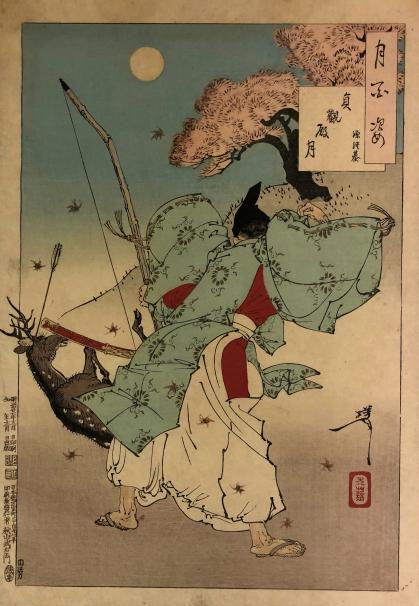
Jōganden Moon, from the series One Hundred Aspects of the Moon
Color woodcut, 1888
Gift of David and Elizabeth Cayer
Jōganden Moon is another ukiyo-e print by Yoshitoshi made for his One Hundred Aspects of the Moon series. Immediately, the moon’s appearance within the night sky sets the stage for Minamoto no Tsunemoto 源経基 (917-961), a skilled samurai warrior hero as it portrays an autumn moonlight evening of 932. The story takes place at Jōganden 貞観殿, a wing of the imperial complex in Kyoto. As Emperor Suzaku 朱雀天皇 (921-952) was strolling through the palace gardens, Tsunemoto shot a demonic deer that was about to attack the emperor. Interestingly enough, the deer in the print represents nothing of the demonic character explained in the story. There is no sense of danger, only a dead deer collapsing in the background; thus, it reduces the print’s impact from the actual story. One would think that with Yoshitoshi’s artistic abilities, he was capable enough of designing horrible beasts. Perhaps he wanted to indicate that there was never a demon, that the creature was never anything but a harmless deer, and that demons are simply figments of the human mind.
Presenting the moon above this historical moment gives the perspective that nothing ever remains the same, for everything is always changing, including the human imagination. This assumption of Yoshitoshi’s intentions could correlate to the appearance of Minamoto no Tsunemoto. Once recognized as a samurai warrior and the Minamoto Clan’s predecessor, he protected Emperor Suzaku and his realm as he fought against rebels. However, with the Meiji Restoration and modernization’s cultural shift, these warrior heroes were no longer idolized. Traditional customs became separated, and the population of samurai declined. The simple image of Tsunemoto killing a weak deer, rather than holding a fierce battle against a demonic creature, implies how unimportant their purpose as samurai was becoming in Japan. Despite the government changes, Yoshitoshi created this print to serve as a gentle reminder for people not to forget its colorful tradition and glorious past. Just as the moon witnessed the fragility of human imagination against the harmless deer, so did it quietly observe the passing time of historical changes happening within the Meiji era.
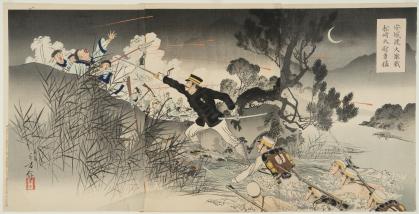
Captain Matsuzaki's Bravery at the Great Fierce Battle of the Anson River
Color woodcut, 1894
Gift of Herbert D. and Ruth Schimmel
Captain Matsuzaki’s Bravery at the Great Fierce Battle of the Anson River is a ukiyo-e print made during the first Sino-Japanese War. Also categorized as a war print (sensō-e 戦争絵), it depicts Captain Matsuzaki 松坂大尉 and his soldiers in battle against the Chinese. The location, referred to in the title as Anson, is the Ansung river in Seoul and was the center stage of the war.
With the beginning of the Meiji era, Western technology and culture became immensely popular in Japan, and traditional Japanese art lost its place in the popular culture. Sensō-e, propaganda prints made twenty years into the Meiji era, marks the end of the centuries-long tradition of ukiyo-e. This work also signifies a major power shift in East Asia. After importing Western technology with the start of the Meiji period, Japan successfully modernized its military and defeated China in the first Sino-Japanese War, a historically dominant force in East Asia. The result of this war meant that Japan was now the most powerful country in East Asia, clearing Japan of any obstacle for further expansion into other countries.
This work is a triptych that can be read as three distinct scenes. Looking from right to left, the first scene features a crescent moon, floating above thick haze and a distant mountain, over the calm surface of the Ansung river and Japanese soldiers quietly surfacing. The center shows the protagonist, Captain Matsuzaki, in a generic brave soldier pose, commanding his soldiers under bullets flying over him. Captain Matsuzaki was likely a natural choice for Toshikata, as he became a national hero as the first Japanese soldier to die in the war. The last scene shows Chinese soldiers awkwardly advancing towards the Japanese, portraying them as incompetent and clumsy as opposed to the Japanese soldiers’ resolute look.
The scenes reveal a progression of time and tumultuousness. The moon helps to create this effect of progression in two ways. First, it helps viewers to start from the top right corner of the print by being the most defined object and placed right next to the title. Second is its placement relative to the subjects of the print. The fact that the moon is placed in the corner of the frame, waning and facing away from the soldiers and the direction of the battle gives viewers an idea that the soldiers are advancing away from their homeland and towards an uncertain future, creating a sense of chronology in the movement of the soldiers.
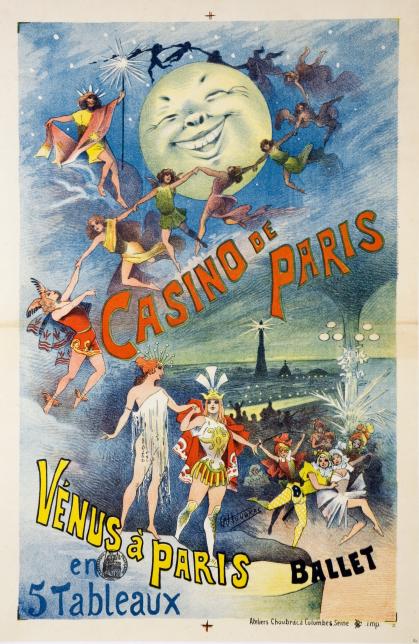
Casino de Paris-Venus à Paris
Color lithograph, 1896
David A. and Mildred H. Morse Art Acquisition Fund
The poster Casino de Paris-Venus à Paris is by Alfred Choubrac (1853-1902), one of the many French nineteenth-century artists who were influenced by Japan. Thinking about how the moon sets the stage in this image, one could interpret the idea literally. The poster functions as an advertisement for the ballet, Venus à Paris, and the moon is setting the stage for the performance to take place. It is an enormous figure in the image and draws people to the poster, and then the ballet at the Casino de Paris. In this performance, the Greek gods Venus and Mars sneak off from Olympus after overhearing Jupiter tell Juno what he saw on Earth. They realize that Venus and Mars are missing and they are eventually discovered at a Parisian ball drinking and dancing (Gutsche-Miller). The line of people winding towards the moon moves the eye across the print and is reminiscent of the passage of time. The smiling moon is having a “good time,” but the light towards the horizon implies night is turning into the morning and the dawn of another day can be a bit melancholic, symbolizing the end of a memorable evening. This print relates to Japanese popular culture in several ways. The moon’s visualization and the people traveling towards it connects to the similar imagery in the Tale of the Bamboo Cutter. In this tenth-century story, Princess Kaguya is met with music and joy as she is brought back to the moon by the heavenly beings. This moment was depicted by artists such as Yoshitoshi who, like Choubrac, represented the divine as human figures. In both Japanese tradition and this French poster, events that happen under the moon are forever moving and the only constant is such movement.
Although various artistic innovations began to develop during this period, the moon continued to remain a popular motif. From Yoshitoshi’s thoughtfully crafted portrayal of a warrior hero, Toshikata’s representation of war, and Choubrac’s advertisement for popular entertainment, the moon’s appearance functions as a quiet acceptance of loss and the inevitable. As each season passes, from morning to night, so does the action of these historical moments. The transience of life’s passing of time will always be reflected underneath the moon, forever being watched by its gentle light.
Amanda Bruce (‘22), Youngjoon Kim (‘22), Jamie Orendain (‘22), David Bellande (‘21)
Bibliography
Fuji Arts Japanese Prints. "Joganden Moon by Yoshitoshi (1839-1892)." Accessed December 01, 2020. www.fujiarts.com/cgi-bin/item.pl?item=810821.
Gutsche-Miller, Sarah. Parisian Music-Hall Ballet, 1871-1913. Rochester, N.Y.: University of Rochester Press, 2015.
Jones, Josh. “Behold the Masterpiece by Japan’s Last Great Woodblock Artist: View Online Tsukioka Yoshitoshi’s One Hundred Apects of the Moon (1885).” Open Culture. www.openculture.com/2017/04/one-hundred-aspects-of-the-moon.html.
